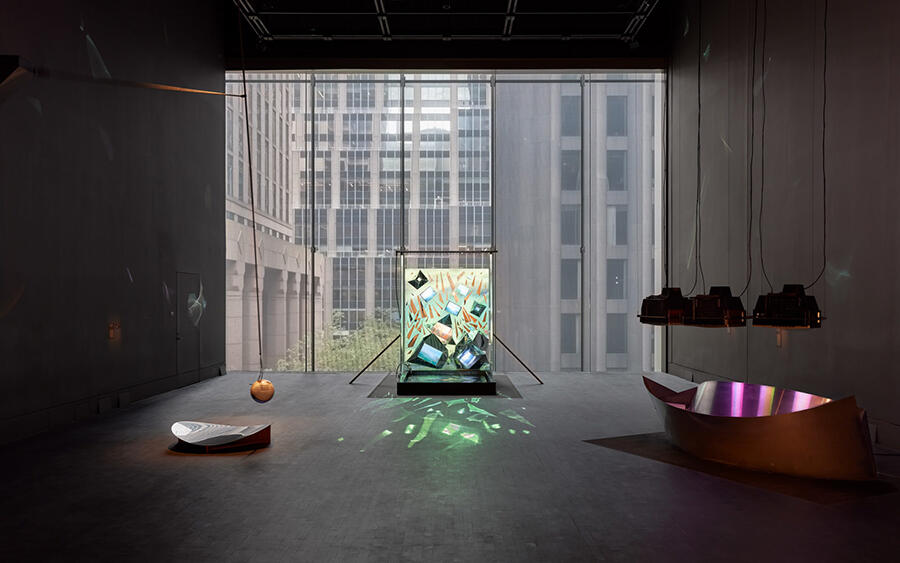The Mesmerizing Effects of Shigeko Kubota’s Video Sculptures
A modest survey at the Museum of Modern of Art, New York, celebrates the trailblazing career of an often-overlooked fluxus artist
A modest survey at the Museum of Modern of Art, New York, celebrates the trailblazing career of an often-overlooked fluxus artist

By the time Shigeko Kubota left Japan for the US in 1964, she had already met John Cage and Yoko Ono, and had her first solo exhibition at Naiqua Gallery, Tokyo, in 1963. Titled ‘1st Love, 2nd Love …’, the show comprised an interactive sculptural installation that, despite Kubota being a feted member of Tokyo’s avant garde, no one wrote about. (She was a woman, after all.) So, when fluxus leader George Maciunas invited her to join him in New York that year, she came without hesitation in the hope of gaining critical recognition. (Shortly after her arrival, Maciunas declared her vice chairman of the group.) There, in the shadow of her far more famous husband, Nam June Paik, she embarked on a series of experiments that culminated in what she described as ‘video sculpture’: video monitors incorporated into three-dimensional structures.
‘Shigeko Kubota: Liquid Reality’ at the Museum of Modern Art, New York (MoMA), highlights this pivotal period in the artist’s career, showcasing seven video works – six of which are sculptural – made between 1976 and 1985. Unsurprisingly, the embrace of intermedia and zen-inspired tendencies of fluxus are present throughout: the movement lurks within the work’s personal, diaristic impetus and its preoccupation with nature as site and subject. Emphasizing Kubota’s prescient engagement with themes of identity, technology and nature, the exhibition reveals the artist’s simultaneous exploration of the ephemeral and monumental qualities of her chosen medium.

The works are arranged across two facing rooms. The first is brightly lit and features minimalist plywood structures embedded with videos, including Three Mountains (1976–79) and Duchampiana: Nude Descending a Staircase (1976). As with most of Kubota’s video sculptures, the imagery flickering on the television screens – footage from her travels to the West Coast and a silhouetted woman doubled by pixels of colour, respectively – oscillates between abstraction and representation, revealing a matrix of associations linking the physical world to the mnemonic. The reductive geometric forms that contain them – a trio of pyramid-shaped structures in Three Mountains and a four-step riser in Duchampiana – harken their eponymous sources, drawing on Kubota’s fascination with nature and art history.
The second gallery, dark and ethereal, houses three kinetic works made largely from steel – River (1979–81), Niagara Falls I (1985) and Video Haiku (1981) – where the exposed bodies of analogue monitors become sculptural objects. Dissolving the boundaries and contours of individual works, the immersive atmosphere underscores the viewer’s subjectivity: the hypnotic sound of water – raining down from the sprinkler system into a pool of water below – and its kaleidoscopic reflections across mirrored surfaces (River and Niagara Falls) merge with the dazzling effects of swinging monitors (River and Video Haiku). Niagara Falls, the most imposing structure in ‘Liquid Reality’, hangs from the ceiling via cables, its backside exposed to a window. Compromising a scaffold of ten cascading CRT monitors whose various sizes create the effect of a cubist rockface, the scenery screened on each capturing the elemental power of Niagara Falls in four seasons. With the addition of an external projector that plays across this fractured surface, the effect is one of disorientation and awe.

Given that MoMA’s 1981 acquisition of Kubota’s Nude Descending a Staircase was their first of a video sculpture, it seems ironic that they waited so long to give her such a modest tribute. That ‘Liquid Reality’ is the artist’s first US solo exhibition in 25 years only adds to this sad testament. Yet, if the promise of brighter horizons in New York eluded her when it came to serious surveys, her tenacity and brilliance as an artist did not.
‘Shigeko Kubota: Liquid Reality’ is on view at the Museum of Modern Art, New York, until 1 January 2021.
Main image: Shigeko Kubota, River (detail), 1979–81, three-channel standard-definition video, cathode-ray tube monitors, stainless steel, plastic mirrors, water and wave machine, dimensions variable. Courtesy: Shigeko Kubota Video Art Foundation, © Estate of Shigeko Kubota, The Museum of Modern Art, New York and VAGA at ARS, New York; photograph: Denis Doorly





















